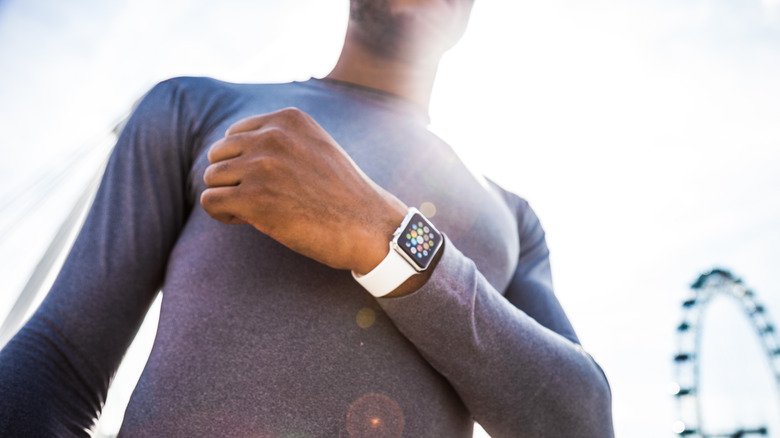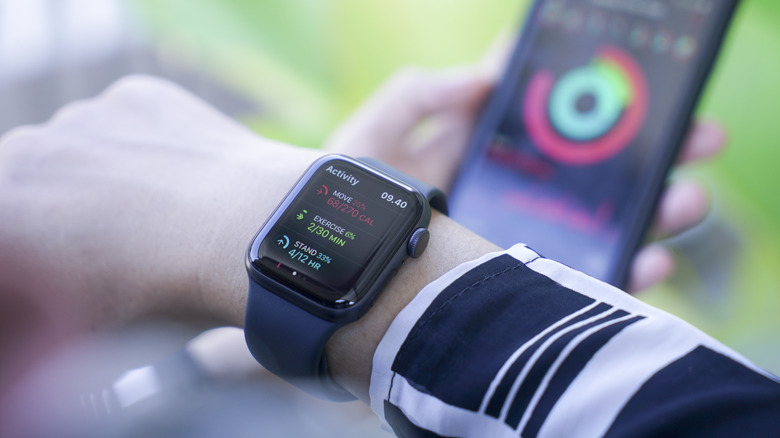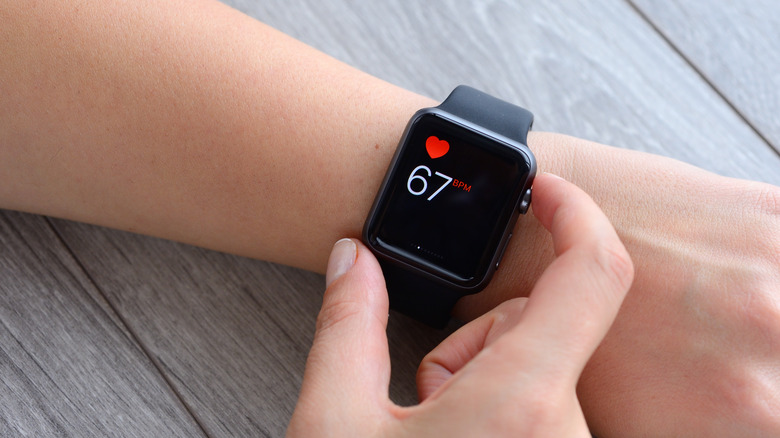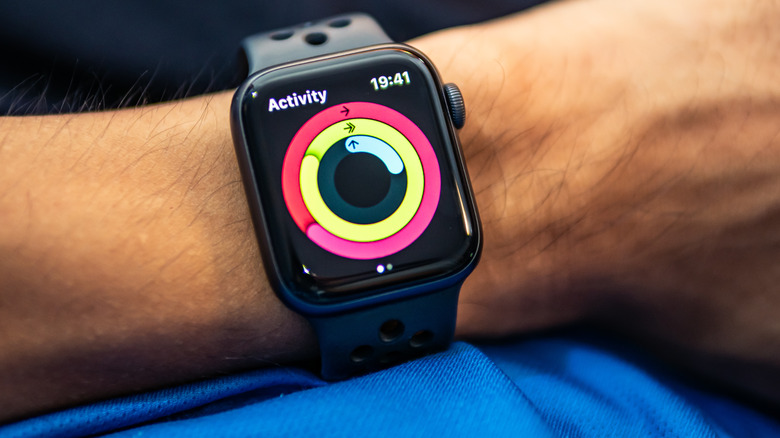How To Get More Out Of Guided Workouts With Your Apple Watch
In 2020, the Global Wellness Institute reported that U.S. consumers invested $265 billion on physical activity — the most of any country. Unfortunately, this doesn't mean that Americans are necessarily healthier because the study also claimed they significantly lags in terms of participation, despite the amount spent.
Compared to other developed countries like Australia, New Zealand, or Norway, wherein participation ranks in the 80 to 90 percentiles, GWI claims that the US only clocked in at 58%. However, emerging technology like the Apple Watch has made it possible for people to integrate fitness into their daily lives.
While it's not a complete replacement for personalized training, the Apple Watch offers a reasonable alternative for people looking to add more movement into their lives at a relatively affordable price point.
If you already have a paired Apple Watch and are paying for an Apple Fitness+ subscription, here are some ways to get your money's worth.
Cross-train
Defined by Healthline as "an exercise protocol that utilizes several modes of training that are outside the athlete's main sport to develop a specific component of fitness," cross-training is a practice that many athletes follow for a range of benefits in and out of a main sport.
When done right, Healthline shares that cross-training can lead to many benefits, such as boosting cardiovascular endurance and better recovery, which are useful even for the average person not just athletes. If you're already investing in other specialized fitness apps for other sports, like boxing or running, you can support these with other workouts through your Apple Fitness+ subscription.
To find new guided workouts, launch the Fitness app on your iPhone and tap Fitness+. Then, you can browse workouts under "try something new" or filter by activity type and find a form of movement you haven't tried before. Under featured activities, you can even check the Simple and Quick or Workouts for Beginners sections, for less intimidating programs.
While the Apple Watch can't detect things like improved flexibility or reduced pain, it does help give additional benchmarks for metrics like heart rate average, VO2 max, and so on.
Stack your workouts
For an effective workout, the succession of movement can matter just as much as the movements themselves. In the right order, you can gradually improve your performance without injuring yourself.
Instead of choosing random or sporadic workouts, you can consult with a professional trainer on recommendations for your particular fitness level. Alternatively, you can also start with the basic formula of warm-up, main workout, and cool down. Then, you can slowly adjust it depending on if you want to progress to harder difficult, or more sets. Either way, your Apple Watch lets you stack workouts.
To create your first Apple Fitness+ Stack, here's how:
-
On your iPhone, open the Fitness+ app.
-
Find the activity that you want to add to your Stack.
-
Tap the activity.
-
In the top-right section, tap the three dots or more icons and tap Add to Stack. Alternatively, you can tap and hold the activity name and tap Add to Stack.
Afterward, you can access your Stacks by tapping the icon in the upper right corner of the screen. Then, you can re-arrange activities, delete activities, and begin or end the workout. With your Apple Watch, you can manage things like starting, pausing, or resuming an activity when it doesn't feel right or you're not ready for it.
By following a Stack, you can develop certain areas of your body in certain ways, such as improved strength or flexibility. By creating the right routine, you can progress safely and at a pace that your body is comfortable with because you'll be able to compare more deliberately.
Train the mind
For some athletes, when you've reached a level of skill where moves feel like play, the game starts to become mental. After all, once you've achieved mastery of what your body can do, the only thing that can convince you to try something you've never done before is your mind.
Through meditation, you can learn to control your breathing and improve mental clarity, which can improve performance and decision-making skills. Unfortunately, meditation is a tricky thing, and many people help before they find what works for them. Some people prefer to meditate in a quiet room. For others, they need to move. If you're part of the latter or suspect that you are, you can use Apple Fitness+ to get started.
To start a guided meditation with your Apple Watch, here's what you need to do:
-
On your Apple Watch, open the Mindfulness app.
-
Tap Fitness+ Audio Mediations.
-
Browse the library to find what kind of meditation you'd like to do. You can tap the "i" icon for more information.
-
Select your preferred meditation by tapping it.
Advertisement
Once the meditation begins, your Apple Watch will keep track of both the elapsed time and your heart rate. With your Apple Watch, you can also pause or end meditations or begin a workout.
Follow a program
If hiring a personal fitness trainer is of reach and you find creating your own program daunting, you can follow an existing workout program in the Fitness+ app.
To do so, simply launch the Fitness+ app on your iPhone and browse the Workout Programs. After choosing what program you like, you can either add one episode by tapping the plus (+) button next to it or selecting Add All at the bottom of the screen to add all the episodes to your library. Alternatively, you can start an episode from the program right away by beginning the workout.
Bear in mind that similar to other workout programs, the Apple Fitness+ programs are designed for the average user. So, while it can be a good benchmark for what the average person can do, people with existing health conditions, physical disabilities, or recovering from injury may not be able to manage at the same rate.
With this, it's important to not get caught up in being able to move at a pace and intensity that is right for you. To do this, you can make use of your Apple Watch's tracking features, like heart rate monitoring, VO2 levels, ECG, and so on.
Get the most from your Apple Watch
Depending on your Apple Watch model, your options for fitness-related features may vary. For example, some models may not have the always-on display, all the health features, and so on. However, how useful all the latest features are will likely depend on your preferred type of fitness activities and where you usually spend most of your time doing them.
Compared to other models, the Apple Watch Ultra 2 is better suited for people who spend a lot of time outdoors. It even has a Siren app, which you can use to emit an 86-decibel sound in the event of an emergency. Although for the average person, the entry-level Apple Watch models may work well enough.
If you haven't already, you may also want to consider learning about all the different LED lights and notifications on your Apple Watch. Whether it's the green light or the red dot, these can give you an insight into what is going on with your device at any given time.
Aside from these guided workout features, there are a lot of other Apple Watch tips and tricks that you might not be aware about yet. Knowing this, you'll probably need to check your Apple Watch model online to get a full view of things that it can or can't do. While you're at it, make sure that your Apple Watch is updated to get its full benefits.





